This year, an estimated 100,000 tourists will visit Antarctic waters. But in any one field season, only 5,000 people globally support scientific research in Antarctica.
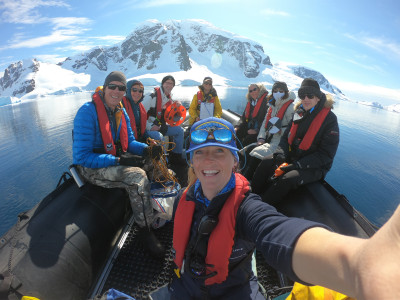
In recent years the latter has often included Allison Cusick, a PhD candidate from UC San Diego’s Scripps Institution of Oceanography who works in the lab of phytoplankton ecologist Maria Vernet. Cusick plans to cruise the Antarctic Peninsula in February 2023, continuing her work with the Fjordphyto citizen science project she co-founded. The program, now funded by NASA, partners with Antarctic tourist ship operators to engage travelers to collect data on phytoplankton abundance, temperature, salinity, and more that helps improve understanding of how melting glaciers are affecting the marine food web. Cusick said about a thousand people participate every year.
More than half a dozen scientists from Scripps Oceanography and the Scripps Polar Center will be venturing to Antarctica for the 2022-23 field season. Two are taking part in the first field season of the National Science Foundation’s (NSF’s) Center for Oldest Ice Exploration (COLDEX), which launched with Scripps Oceanography as a partner last year.
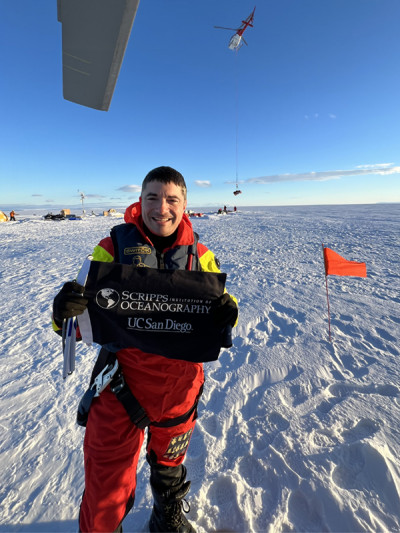
The COVID-19 pandemic eliminated the 2020-21 field season. And even though four Scripps Oceanography researchers returned to Antarctica in 2021-22, precautions still exert lingering effects on logistics and supply chains. Graduate student Austin Carter and research geophysicist Jamin Greenbaum, for example, both experienced two-week travel delays.
This year’s field season is also the first since the release of a report issued by the NSF’s Office of Polar Programs on Sexual Assault/Harassment Prevention and Response. The report acknowledged that problems exist and recommended a plan to better address and prevent sexual harassment and sexual assault in the U.S. Antarctic Program.
“We’re putting in quite a bit of time and effort into how we can develop a bottom-up approach to protect our teams,” Jamin Greenbaum said. “That’s definitely front and center this year.”
Greenbaum organized two four-hour bystander workshops before the field season commenced about how crew members should intervene if they see bullying and harassment in the field. About 45 people from multiple field teams and institutions attended. The Scripps Polar Center also organized a Town Hall on this issue in November 2022.
Citizen scientists collect key data
Cusick will continue to collect samples to better understand how phytoplankton respond to melting glaciers along the coast of the western Antarctic Peninsula. These microscopic organisms account for more than half the planet’s annual variability in atmospheric oxygen.
She has spent more than 300 days in six summer field seasons in Antarctica, with stays ranging from one to three months. Last season she went from late November to early January and again in March.
“While I was there in March, toward the end of the season, we went south of the polar circle,” Cusick said. “Typically, phytoplankton mostly grow in the beginning of spring and peak summer.” But the water samples that she and the passengers collected contained a large mass of phytoplankton.
“Satellite data showed a bloom of phytoplankton at the same location,” Cusick noted, a successful verification that orbital data matches data collected on the ocean surface.
“That was late summer getting into fall,” she said. “This shift in the phytoplankton types we see in fjords over the whole season through this citizen science approach with the tour industry is novel. Typically, a research vessel samples for one or two months. But with FjordPhyto, we can be there five months every year, moving up and down the western Antarctic Peninsula that entire time.”
Predators of marine bacteria
Biological oceanographer Jeff Bowman is on his fourth trip to Antarctica. It is the second for Beth Connors, a PhD student in Bowman’s lab. Both conducted research as part of the Long-Term Ecological Research Project (LTER) at Palmer Station, a U.S. research outpost on Anvers Island near the Antarctic Peninsula. Bowman visited in 2015 and Connors in 2019-2020. They collected samples twice weekly by boat to analyze microbial DNA and abundance.
Bowman also collected microbial RNA, including samples from below sea ice, providing the basis for his primary research that followed. And, as in January 2020, Connors will take part in the annual LTER cruise, taking samples along a standard grid of marine stations off the western Antarctica Peninsula.
This season the duo will study how marine bacteria function in Antarctic food webs through Bowman’s NSF CAREER award.
“Bacteria are the most numerous organisms in any ecosystem and play a critical role in recycling organic carbon as a food source for other organisms,” Bowman said. The bacteria are eaten by small organisms called protists, which are eaten in turn by larger organisms. But a viral process that kills bacteria can suppress the transfer of carbon to other organisms.
“We’re trying to understand when each mode of mortality dominates and why,” he said.
Connors will focus much of her PhD on the data collected this season.
“I am excited to see how the ecological trends change with the season, and if viruses or protists are the more dominant predator at a particular time of year and why that might be,” she said.
Icy clues to dramatic climate change
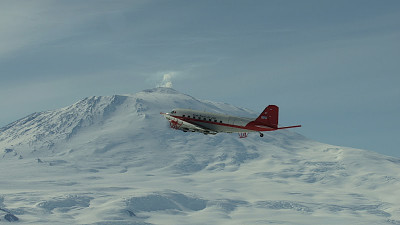
This season’s trip will be Greenbaum’s 15th to Antarctica. During his successful field season last year, covered extensively in The New Yorker, he collected data on the melting and retreat of Thwaites Glacier. This season he will collect airborne geophysical measurements as part of a team led by the University of Texas Institute for Geophysics. A Basler BT-67 aircraft will fly with ice-penetrating radar, laser altimetry, a gravimeter, a magnetometer, and a camera system.
“Radar data gives you the ice thickness. It also tells you the conditions of the ice at the bottom. Is it wet, dry, melting, rough, or smooth? All of that is important for the numerical ice models. We also collect gravity and magnetics data, which when combined with the radar, allows us to infer the geology,” Greenbaum said. Laser altimetry, meanwhile, provides precise data on ice surface elevation.
“The goal is to find the most promising sites for recovering ice cores that may contain ice up to 1.5 million years old,” said Greenbaum, a COLDEX co-Investigator. Such ancient ice could reveal why Earth’s climate changed dramatically sometime between 1.5 million and 800,000 years ago.
Ice Age cycles previously lasted 40,000 years. The current cycle is 100,000 years. That climate stability, he said, is “critical to understand, especially if there is any reason to believe the system can change dramatically again in the future.”
Coring old ice in the Allan Hills
Austin Carter, a member of Sarah Aarons’ Climate & Earth Surface Geochemistry Group, returns to Antarctica as part of the COLDEX collaboration. He spent the 2019-20 field season in Antarctica’s Allan Hills on a team that drilled three ice cores.
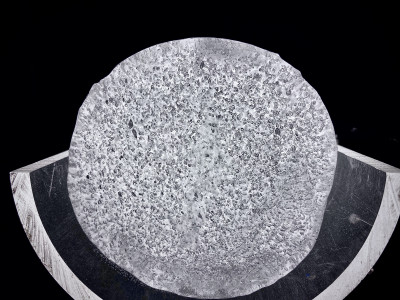
“One core was really old ice, between 2 and 3 million years old. And then I had a younger core that went across a glacial-interglacial transition,” Carter said. That ice, for his PhD work, spans a period from about 120,000 to 145,000 years ago.
“The questions that I’m focusing on are, where is the mineral dust, these tiny bits of glacially derived rock, coming from? And how is it getting to this location in Antarctica?”
Carter uses what he calls “dust forensics” to answer these questions. A recent article he co-wrote for Past Global Changes Magazine describes how ice cores provide insights into Earth’s climate history. This season he will revisit an area that yielded ancient ice three years ago in hopes of pulling up even more.
“If there’s time, we’re hoping to get preliminary information about where there could be even older ice and try to drill there,” Carter said. A successful quest for 1.5-million-year-old ice may show if and how dust fertilizes distant reaches of the ocean.
“The only source of nutrients that typically reach the remote surface ocean is dust because it’s transported in the atmosphere,” Aarons said. About 1.5 million years ago, the Earth’s glacial periods became colder and lengthened. Dust fertilization of the surface ocean and its impact on atmospheric carbon dioxide may have caused this change.
“No records of dust this old beyond marine sediment cores have been developed,” Aarons said. “This would be the first ice-core record of dust composition, deposition, and flux from this time period. I’m excited for him to get new samples and bring them back to the lab.”
Aarons, an isotope geochemist, is following Carter’s progress from home this year. She has, however, made two trips to Taylor Glacier in East Antarctica.
“For me, it was the closest experience to being on another planet,” Aarons said. “You’re far from home. Barely anyone has been to the spot you’re standing in. It felt almost sacred."
Understanding Ice Sheet Mass Loss
Scripps Polar Center co-lead and Professor of Glaciology Helen Amanda Fricker is joining an expedition to the Antarctic Peninsula with EYOS aboard the icebreaker Legend beginning in late January. Fricker will be part of a small international science team looking into how ice sheet mass loss processes can be better understood with satellite observations and modeling.
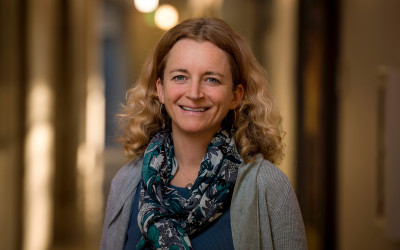
Fricker is a renowned glaciologist widely recognized for her discovery of active subglacial lakes in Antarctica and her work as a science advisor to NASA’s ice-measuring satellite missions. In 2021, the U.K. Antarctic Place-Names Committee honored her by naming an Antarctic ice piedmont, an ice-covered coastal strip of low-lying land backed by mountains, in her honor. The route for the voyage is planned to include Fricker Ice Piedmont, located on the eastern side of Adelaide Island.
“I am looking forward to traveling to this region of Antarctica and seeing it for myself,” Fricker said.
Avoiding thin ice
Research physiologist Paul Ponganis had planned to lead a contingent of scientists from UC San Diego and elsewhere to Penguin Ranch, a camp that was to be set up on the sea ice near McMurdo Station. Thin ice canceled the trip to study the diving physiology of emperor penguins, which was supposed to be Jessica Kendall-Bar's first Antarctic field season. Kendall-Bar, a Scripps postdoctoral scholar, works with Ponganis in the Center for Marine Biotechnology and Biomedicine.
The team plans to try again next season, continuing part of a larger body of work that includes research on extreme divers such as seals, penguins, and even humans. Their goal: learn more about diving physiology and various dive-related pathologies.
Normally, the sea ice at Penguin Ranch measures about six and a half feet thick. But this year it averaged only half as much, not thick enough to support the heavy equipment needed to set up camp on the sea ice.
“It was not possible to set up the camp where it’s been set up for the past 60 years to do that kind of research,” Kendall-Bar said.
Follow Scripps scientists from the field on the following social platforms as they aim to post updates when time and internet connections allow: Austin Carter on TikTok at @AustinCarter642, the Bowman Lab on Instagram at @Polar_Microbes, Allison Cusick on Twitter at @Woman_Scientist and @Fjordphyto, Helen Fricker on Twitter at @HelenAFricker, and Jamin Greenbaum at @JaminGreenbaum.
About Scripps Oceanography
Scripps Institution of Oceanography at the University of California San Diego is one of the world’s most important centers for global earth science research and education. In its second century of discovery, Scripps scientists work to understand and protect the planet, and investigate our oceans, Earth, and atmosphere to find solutions to our greatest environmental challenges. Scripps offers unparalleled education and training for the next generation of scientific and environmental leaders through its undergraduate, master’s and doctoral programs. The institution also operates a fleet of four oceanographic research vessels, and is home to Birch Aquarium at Scripps, the public exploration center that welcomes 500,000 visitors each year.
About UC San Diego
At the University of California San Diego, we embrace a culture of exploration and experimentation. Established in 1960, UC San Diego has been shaped by exceptional scholars who aren’t afraid to look deeper, challenge expectations and redefine conventional wisdom. As one of the top 15 research universities in the world, we are driving innovation and change to advance society, propel economic growth and make our world a better place. Learn more at ucsd.edu.



